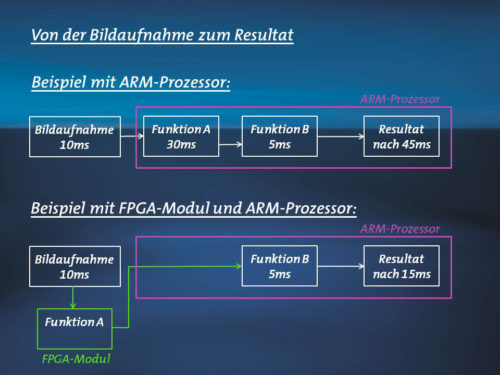Major power boost through FPGA programming and ARM processor
Major power boost through FPGA programming and ARM processor
Implementation done by experts
Ettlingen – Optimized FPGA programming for image processing routines enables the system to execute twenty times faster. This performance boost is made possible by relocating selected features from the ARM processor to the FPGA module. The advantage: captured image data is being pre-processed by the FPGA module while still on its way to the memory. Data processing is therefore already partially completed by the time the image is written to the ARM processor’s memory for further processing. This parallel processing of image data significantly reduces the overall processing time – by the execution time the same function would have required in the ARM processor. In order for users to fully take advantage of the benefits of the FPGA module for image processing tasks, Vision Components has equipped the Z camera series with a ZYNC© SoC module from Xilinx©, which enables free programming. These compact, high-performance cameras feature low-power consumption and are therefore particularly suited for high-speed applications with limited installation space.
Experience has shown that it is advisable to check in advance whether FPGA programming is the best solution for a given application. Since programming requires a high degree of experience and expertise, Vision Components offers customers comprehensive consultation services on all things FPGA programming and carries out implementation of the desired function on request. An integrated development environment then enables advanced testing and debugging of all programmed FPGA functions before deployment. This greatly simplifies troubleshooting and significantly reduces development time. In addition, the company’s proprietary VCLib provides users with a ready-to-use function package that includes color processing, various filter routines, pattern matching, and much more. The software library comprises image processing expertise gathered in more than 30 years and allows for quick and effective FPGA code compilation and translation. The library contains all standard image processing functions for industrial applications that can be used either in the ARM processor or FPGA module, whichever will achieve the best possible performance for each application.

